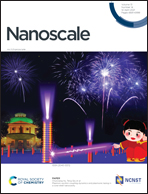Red, orange, yellow and green luminescence by carbon dots: hydrogen-bond-induced solvation effects†
Abstract
The mechanism of the solvation-dependent multicolor luminescence of carbon dots (CDs) is not clear, despite the fact that multicolor luminescent CDs have important applications in many fields. In this article, we report solvated chromogenic CDs with productivity of up to 57%. The luminescence of the CD particles exhibits a regular redshift in N,N-dimethylformamide (DMF), ethanol, water, and acetic acid. The redshift of the CDs may be ascribed to the linking of the CD surfaces to the solvent through hydrogen bonds (HB). Different surface level states are formed by HB between the surfaces of the CDs and the solvent, and differences in dispersion states lead to different energy resonance transfer (ETR) efficiencies. The CDs/B2O3 composite exhibits excellent fluorescence thermal stability, and it has also been used to manufacture white-light-emitting devices with a high color rendering index of 87. Additionally, the excellent solvation effects of the CDs have application prospects in the detection of the water content in organic solvents. Finally, the CDs are used to realize cell imaging and positioning, which has significant application prospects in biological fields.



 Please wait while we load your content...
Please wait while we load your content...